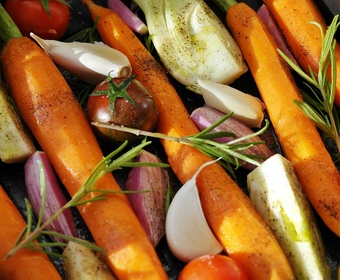
PREPARING VEGETABLES
- Get as much out of them as possible. Maximize flavors.
- Add salt and acidity in advance.
- Practice your knife skills.
- “You can pickle everything.”
- Today’s vegetables are tomorrow’s vegetable stock.
Some vegetables are so fresh they couldn’t be fresher, others should be boiled soft, peeled, salted, pickled, etc. (see each group of vegetables). But there are a few general guidelines:
Get as much out of them as possible
Use as much of your vegetables as you can. Use the stems of cauliflowers, the tops of beetroot and the green bit at the end of leeks. Use these bits as a salad, garnish, for extra flavor (e.g. in a meat stew), and so on. Or fry them in butter and drizzle with salt. (It’s just a question of time before some health guru with a head for business puts these usually unwanted bits in a bag and sells them as the latest thing...)
Use what you have. Sometimes it’s easier when you just have to go on what you’ve got.
– Joel Aronsson, Fäviken, Krakas and other restaurants
Knife practice makes for knife skills
Chopping an onion is a basic technique that every cook has to master – and it’s not the only one. The more you prepare all kinds of vegetables, the better you’ll be at picking out what will look good on the plate and taste good too. Sometimes a small paring knife can be better than a big chef’s knife. You need a big, sturdy chopping board.
Maximum flavor
With many vegetables most of the flavor is in the peel and the coarser parts. Make sure you don’t overdo it with the peeler and miss out on the best bits. If you’ve got great-looking washed vegetables, often all you need to do is rinse them.
Plan in your leftovers
Vegetables and unused ends and tops are often a great source of flavor for future dishes. Think ahead and save them. Leftover root vegetables and cabbages – the bits you cut off to start with and the cooked ones that were left over – make an excellent base for a meat sauce (instead of those dry cubes with "stock" which contain almost nothing but salt). Remember that you can freeze them, run them through a food processor, cover them with oil, salt them, preserve them in vinegar...
Dry salt greens
Prepare crispy vegetables – e.g. for a salad – by dry salting them the day before. Rub dry salt into carrots or fennel, for example, and leave them overnight. It improves the flavor and makes them crispier.
Salt and acidity
Adding salt and acidity – and maybe sugar too – makes vegetables more interesting. You can it as a cooking method or as a way of preparing them so that they give their best on the plate.
1–2–3 solution
One part acidity, two parts sugar and three parts water. There isn’t an easier way of improving the flavor of almost any vegetable you can think of. If you’re not so keen on this sweet pickling method, which is common in Scandinavia, there are plenty of saltier alternatives.
You can pickle everything.
– Joel Aronsson


